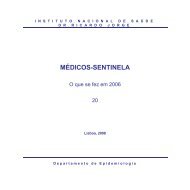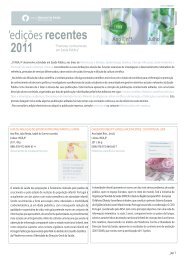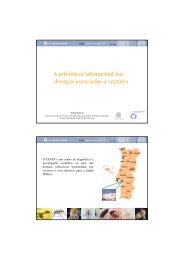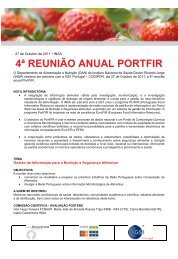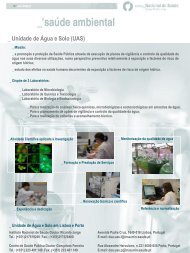European Society of Mycobacteriology - Instituto Nacional de Saúde ...
European Society of Mycobacteriology - Instituto Nacional de Saúde ...
European Society of Mycobacteriology - Instituto Nacional de Saúde ...
You also want an ePaper? Increase the reach of your titles
YUMPU automatically turns print PDFs into web optimized ePapers that Google loves.
GL-7<br />
A NOVEL DIAGNOSTIC TEST TO DIFFERENTIATE<br />
LATENT TB INFECTION AND ACTIVE DISEASE<br />
Lee W. Riley<br />
MD, School <strong>of</strong> Public Health, University <strong>of</strong> California, Berkeley<br />
It is well recognized that the treatment <strong>of</strong> latent TB infection (LTBI) is a highly effective TB prevention strategy, which is<br />
still not wi<strong>de</strong>ly practiced in most parts <strong>of</strong> the world. Most TB-en<strong>de</strong>mic countries rely on BCG vaccine to prevent TB.<br />
LTBI treatment requires contact investigation, which is not done in most “BCG countries”. One reason for this reluctance<br />
to practice contact investigation is the lack <strong>of</strong> a reliable test that can distinguish LTBI from TB. Thus, a test that can<br />
unequivocally distinguish LTBI from TB could alter the current national prevention programs in TB-en<strong>de</strong>mic countries.<br />
We have i<strong>de</strong>ntified a set <strong>of</strong> M. tuberculosis cell wall proteins that are expressed when the bacilli replicate in vivo, but not<br />
when they are in a nonreplicative state. Their continued expression is associated with disease progression in infected<br />
mice, and mouse T cells are sensitized as these proteins are continually expressed in vivo. Exploiting this observation, we<br />
<strong>de</strong>veloped a bioassay that is able to distinguish LTBI from active disease in a mouse mo<strong>de</strong>l. The assay is based on IFNγ<br />
induction by T cells exposed to a set <strong>of</strong> synthetic pepti<strong>de</strong>s based on the cell wall protein called Mcep1A. The Cornell<br />
mouse mo<strong>de</strong>l was used to study the response <strong>of</strong> spleen cells exposed ex vivo to these pepti<strong>de</strong>s. Cells from untreated<br />
mice expressed 7-9-fold higher levels <strong>of</strong> IFNγ than those from treated mice at 24 and 32 weeks <strong>of</strong> infection, as measured<br />
by ELISA. Blood cells from healthy tuberculin skin-test positive, QuantiFERON-negative (n=3) and TST-negative,<br />
QuantiFERON-negative (n=3) human volunteers showed no response to the pepti<strong>de</strong>s. These pepti<strong>de</strong>s are currently<br />
un<strong>de</strong>r evaluation in newly diagnosed TB patients. If the assay can show a response in these TB patients at levels similar<br />
to those observed in diseased mice, this assay can be converted into an immunochromatographic (“dip stick”) format.<br />
Such a test then can be used to readily differentiate those with LTBI and active disease, and could then be incorporated<br />
as part <strong>of</strong> National TB Control Programs.<br />
32 ESM 2009



